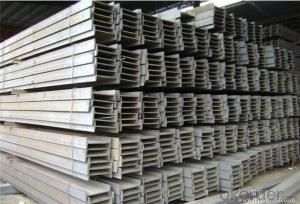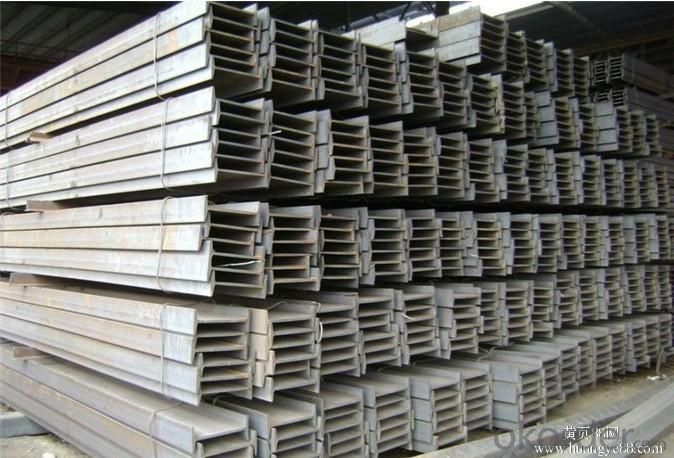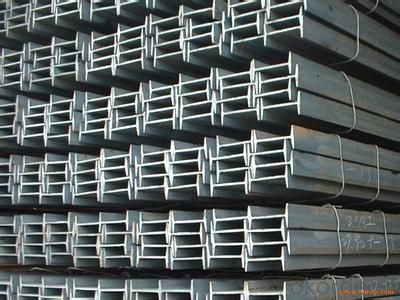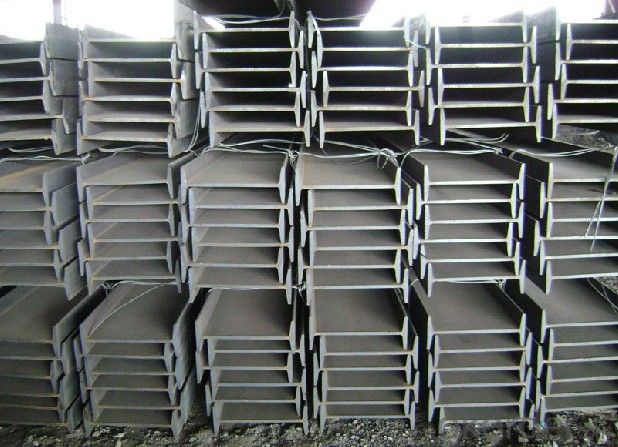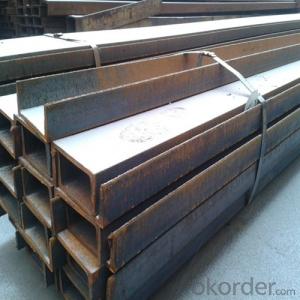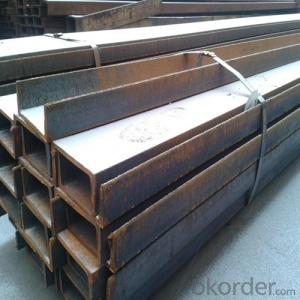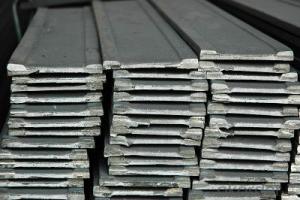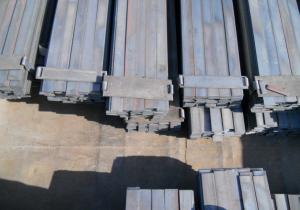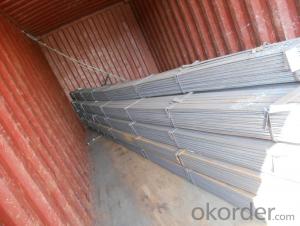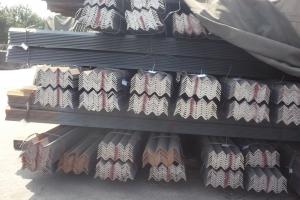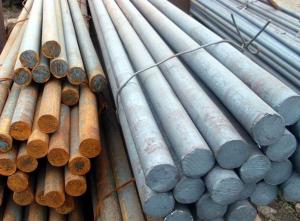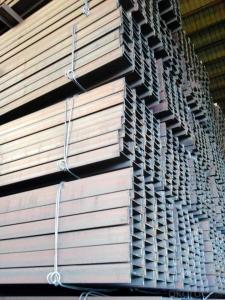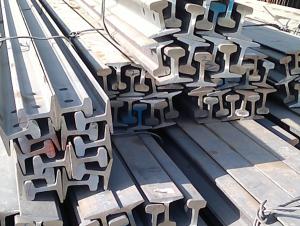Q235 Barbon Steel I Beam Bar
- Loading Port:
- China Main Port
- Payment Terms:
- TT or LC
- Min Order Qty:
- -
- Supply Capability:
- -
OKorder Service Pledge
OKorder Financial Service
You Might Also Like
Product Description:
OKorder is offering Q235 Barbon Steel I Beam Barat great prices with worldwide shipping. Our supplier is a world-class manufacturer of steel, with our products utilized the world over. OKorder annually supplies products to European, North American and Asian markets. We provide quotations within 24 hours of receiving an inquiry and guarantee competitive prices.
Product Applications:
Q235 Barbon Steel I Beam Bar are ideal for structural applications and are widely used in the construction of buildings and bridges, and the manufacturing, petrochemical, and transportation industries.
Product Advantages:
OKorder's Q235 Barbon Steel I Beam Bar are durable, strong, and resist corrosion.
Main Product Features:
· Premium quality
· Prompt delivery & seaworthy packing (30 days after receiving deposit)
· Corrosion resistance
· Can be recycled and reused
· Mill test certification
· Professional Service
· Competitive pricing
Product Specifications:
Manufacture: Hot rolled
Grade: Q195 – 235
Certificates: ISO, SGS, BV, CIQ
Length: 6m – 12m, as per customer request
Packaging: Export packing, nude packing, bundled
Chinese Standard (H*W*T) | Weight (Kg/m) | 6m (pcs/ton) | Light I (H*W*T) | Weight (Kg/m) | 6m (pcs/ton) | Light II (H*W*T) | Weight (Kg/m) | 6M |
100*68*4.5 | 11.261 | 14.8 | 100*66*4.3 | 10.13 | 16.4 | 100*64*4 | 8.45 | 19.7 |
120*74*5.0 | 13.987 | 11.9 | 120*72*4.8 | 12.59 | 13.2 | 120*70*4.5 | 10.49 | 15.8 |
140*80*5.5 | 16.89 | 9.8 | 140*78*5.3 | 15.2 | 10.9 | 140*76*5 | 12.67 | 13.1 |
160*88*6 | 20.513 | 8.1 | 160*86*5.8 | 18.46 | 9 | 160*84*5.5 | 15.38 | 10.8 |
180*94*6.5 | 24.143 | 6.9 | 180*92*6.3 | 21.73 | 7.6 | 180*90*6 | 18.11 | 9.2 |
200*100*7 | 27.929 | 5.9 | 200*98*6.8 | 25.14 | 6.6 | 200*96*6.5 | 20.95 | 7.9 |
220*110*7.5 | 33.07 | 5 | 220*108*7.3 | 29.76 | 5.6 | 220*106*7 | 24.8 | 6.7 |
250*116*8 | 38.105 | 4.3 | 250*114*7.8 | 34.29 | 4.8 | 250*112*7.5 | 28.58 | 5.8 |
280*122*8.5 | 43.492 | 3.8 | 280*120*8.2 | 39.14 | 4.2 | 280*120*8 | 36.97 | 4.5 |
300*126*9 | 48.084 | 3.4 | 300*124*9.2 | 43.28 | 3.8 | 300*124*8.5 | 40.87 | 4 |
320*130*9.5 | 52.717 | 3.1 | 320*127*9.2 | 48.5 | 3.4 | |||
360*136*10 | 60.037 | 2.7 | 360*132*9.5 | 55.23 | 3 |
FAQ:
Q1: Why buy Materials & Equipment from OKorder.com?
A1: All products offered byOKorder.com are carefully selected from China's most reliable manufacturing enterprises. Through its ISO certifications, OKorder.com adheres to the highest standards and a commitment to supply chain safety and customer satisfaction.
Q2: How do we guarantee the quality of our products?
A2: We have established an advanced quality management system which conducts strict quality tests at every step, from raw materials to the final product. At the same time, we provide extensive follow-up service assurances as required.
Q3: How soon can we receive the product after purchase?
A3: Within three days of placing an order, we will begin production. The specific shipping date is dependent upon international and government factors, but is typically 7 to 10 workdays.
Q4: What makes stainless steel stainless?
A4: Stainless steel must contain at least 10.5 % chromium. It is this element that reacts with the oxygen in the air to form a complex chrome-oxide surface layer that is invisible but strong enough to prevent further oxygen from "staining" (rusting) the surface. Higher levels of chromium and the addition of other alloying elements such as nickel and molybdenum enhance this surface layer and improve the corrosion resistance of the stainless material.
Q5: Can stainless steel rust?
A5: Stainless does not "rust" as you think of regular steel rusting with a red oxide on the surface that flakes off. If you see red rust it is probably due to some iron particles that have contaminated the surface of the stainless steel and it is these iron particles that are rusting. Look at the source of the rusting and see if you can remove it from the surface.
Images:
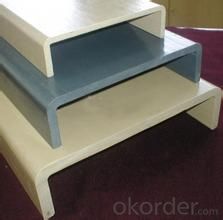
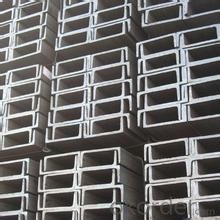
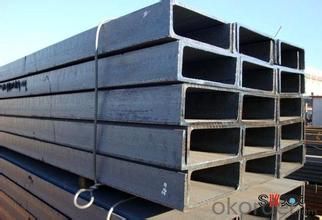
- Q: What is the material of hot rolled ordinary I-beam?
- I-beam is also called steel girder (English name Universal Beam). It is a strip of steel with an I-shaped section. I-beam is made of ordinary I-beam and light i-beam. It is a section steel with an I-shaped section.
- Q: How do steel I-beams contribute to the overall sustainability of a structure?
- Steel I-beams play a vital role in enhancing the sustainability of structures in several ways. To begin with, steel is a highly recyclable material, allowing I-beams to be produced and recycled using recycled steel. This reduces the demand for new steel production and lessens the environmental impact of extracting and processing raw materials. Furthermore, steel I-beams are renowned for their strength and durability. By incorporating steel I-beams in construction, buildings can be designed to have a longer lifespan, reducing the need for frequent repairs or replacements. This extended lifespan helps conserve resources and minimize waste. In addition, energy efficiency is another aspect of sustainability that steel I-beams contribute to. Steel is an excellent conductor of heat, enabling the efficient distribution of heat throughout a structure. Consequently, energy consumption for heating and cooling purposes can be reduced, resulting in lower energy bills and a smaller carbon footprint. Moreover, steel I-beams are lightweight yet sturdy, allowing for more efficient transportation and installation. The reduced weight leads to lower fuel consumption during transportation, while the ease of installation saves time and labor costs. Overall, this enhances the sustainability of the construction process by reducing energy use and associated emissions. Lastly, steel I-beams offer design flexibility, enabling more creative and innovative architectural designs. This flexibility leads to more efficient use of space, reduced material waste, and improved functionality, all of which contribute to the overall sustainability of the structure. To conclude, steel I-beams significantly contribute to the overall sustainability of structures through their recyclability, strength and durability, energy efficiency, lightweight design, and design flexibility. By incorporating steel I-beams into construction projects, we can create environmentally friendly and sustainable buildings that minimize resource consumption, waste generation, and energy use.
- Q: What are the common methods of installing steel I-beams in existing structures?
- The common methods of installing steel I-beams in existing structures include using temporary supports, removing a portion of the existing structure, placing the I-beam in position, and then securing it with bolts or welding. Another method involves using a crane to lift the I-beam into place, followed by attaching it to the existing structure using welding or bolting techniques.
- Q: Can steel I-beams be used for temporary support during renovations or repairs?
- Yes, steel I-beams can be used for temporary support during renovations or repairs. Their strong and sturdy construction makes them suitable for providing temporary structural support while work is being done on a building.
- Q: What's the meaning of the steel structure "I-beam 150x8 400x10 flange Web"?
- I 150x8 400x10 flange web writing is not standardized, but probably understand its meaning, the width of flange plate thickness of 8 to 150.
- Q: Are there any health and safety considerations when working with steel I-beams?
- When working with steel I-beams, there are multiple health and safety considerations to take into account. These considerations encompass the following: 1. Personal Protective Equipment (PPE): To safeguard against potential dangers such as falling objects, cuts, and impacts, workers must consistently wear suitable PPE including safety glasses, steel-toed boots, gloves, and hard hats. 2. Manual Handling: Proper lifting techniques are necessary to prevent strains, sprains, or other musculoskeletal injuries caused by the weight of steel I-beams. Workers should undergo adequate training on safe lifting and moving methods, and whenever possible, mechanical lifting aids should be utilized. 3. Structural Stability: Prior to commencing work with steel I-beams, it is crucial to verify the stability and capacity of the supporting structure to prevent collapse or structural failures. Structural engineers should assess the integrity of the structure to ensure it can withstand the weight of the beams and the workers. 4. Falls from Heights: Given that working with steel I-beams often involves tasks performed at elevated positions during installation or maintenance, measures for fall protection such as guardrails, safety nets, or personal fall arrest systems must be in place. These precautions are vital to prevent falls and safeguard workers against severe injuries. 5. Welding and Cutting Hazards: The fabrication or modification of steel I-beams may necessitate welding or cutting processes that produce hazardous fumes, sparks, and intense heat. To minimize risks associated with these operations, adequate ventilation, fire prevention measures, and comprehensive training in welding and cutting techniques are imperative. 6. Hazardous Materials: Certain steel I-beams may be coated with paints, coatings, or preservatives containing hazardous substances like lead or asbestos. Workers should be aware of these potential hazards and follow proper safety procedures, such as utilizing respiratory protection and employing appropriate handling techniques, to prevent exposure. In summary, working with steel I-beams necessitates strict adherence to safety protocols in order to protect workers from various hazards arising from the weight, structural integrity, height, welding processes, and potential exposure to hazardous materials.
- Q: How do steel I-beams perform in seismic or earthquake-prone areas?
- Steel I-beams are commonly used in seismic or earthquake-prone areas due to their excellent performance during seismic events. The inherent strength and ductility of steel allow I-beams to absorb and distribute seismic forces, reducing the risk of structural failure. Additionally, the flexibility of steel I-beams helps them resist lateral movement, ensuring better stability and minimizing damage during earthquakes. Overall, steel I-beams are a reliable and preferred choice for construction in seismic regions.
- Q: Can steel I-beams be used in the construction of high-rise buildings?
- Yes, steel I-beams can be used in the construction of high-rise buildings. Steel I-beams offer excellent structural integrity and load-bearing capacity, making them a popular choice for constructing tall buildings. The I-beam's design allows for efficient distribution of weight and provides the necessary strength to support the multiple floors and heavy loads typically found in high-rise structures. Additionally, steel I-beams offer flexibility in design and can be easily fabricated and installed, making them a preferred choice for architects and engineers in constructing high-rise buildings.
- Q: What are the typical connection methods for steel I-beams?
- The typical connection methods for steel I-beams include welding, bolting, and riveting. Welding is a common method where the beams are fused together using heat, creating a strong and continuous connection. Bolting involves using bolts and nuts to fasten the beams together, providing a secure connection that can be easily disassembled if needed. Riveting is another method where metal pins called rivets are used to join the beams by passing them through pre-drilled holes and then hammering them to create a permanent connection. These connection methods ensure the stability and structural integrity of steel I-beams in various applications.
- Q: Can steel I-beams be used for convention centers or exhibition halls?
- Yes, steel I-beams can be used for convention centers or exhibition halls. Steel I-beams are commonly used in construction for their strength and durability, making them suitable for large and open spaces like convention centers or exhibition halls. They provide structural support and can withstand heavy loads, making them an ideal choice for such large-scale venues.
Send your message to us
Q235 Barbon Steel I Beam Bar
- Loading Port:
- China Main Port
- Payment Terms:
- TT or LC
- Min Order Qty:
- -
- Supply Capability:
- -
OKorder Service Pledge
OKorder Financial Service
Similar products
Hot products
Hot Searches
Related keywords
